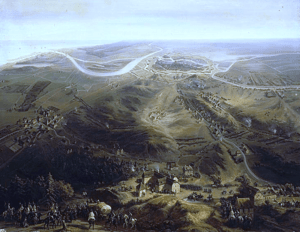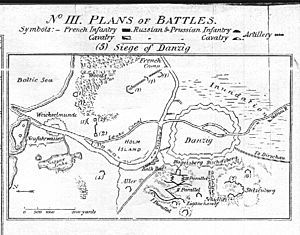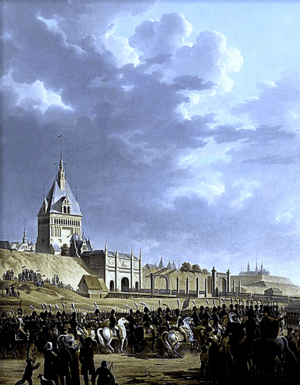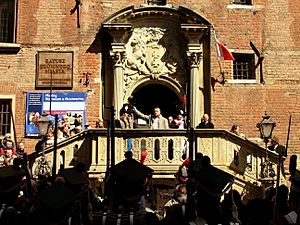Siege of Danzig (1807) facts for kids
Quick facts for kids Siege of Danzig |
|||||||
|---|---|---|---|---|---|---|---|
| Part of the War of the Fourth Coalition | |||||||
 "Panoramic view of the siege of Danzig by French forces in 1807" painting by Jean-Antoine-Siméon Fort |
|||||||
|
|||||||
| Belligerents | |||||||
| Commanders and leaders | |||||||
| Strength | |||||||
| 39,000 100 heavy guns & mortars |
16,000 (siege) 8,000 Russians (reinforcements) |
||||||
| Casualties and losses | |||||||
| 6,000 (siege) 400 (relief attempt) |
10,000 (siege) 1,500 (relief attempt) |
||||||
The Siege of Danzig was a major battle during the War of the Fourth Coalition. It took place from March 19 to May 24, 1807. During this time, French forces surrounded and captured the city of Danzig (which is now Gdańsk in Poland).
About 27,000 French soldiers, led by Marshal Lefebvre, surrounded Danzig. Inside the city, about 14,400 Prussian soldiers, led by Marshal Kalckreuth, defended it. This siege was an important part of the larger war.
Contents
Why Danzig Was So Important
Danzig was a very important city for several reasons during the war.
- Strategic Location: It was a heavily fortified port city with 60,000 people. It sat at the mouth of the Vistula river.
- Threat to French Army: The city was located in Prussian territory. This meant it was behind the French army as they moved east. It could be a dangerous threat to their side.
- Supply Point: Danzig was a good place for enemy troops to land. They could open a new battlefront behind the French army.
- Difficult to Attack: The city was hard to attack. You could only reach it from the west. All other sides were protected by the Vistula river or by swampy lands.
- Valuable Resources: Danzig also had important supplies. These included gunpowder, grain, and alcohol. The French army, called the Grande Armée, needed these for their big campaign in the east.
Napoleon, the French emperor, knew how important Danzig was. In a letter on February 18, 1807, he told Marshal Lefebvre:
Your glory is linked to the taking of Danzig: you must go there.
Who Fought in the Siege
The job of capturing Danzig was given to Marshal Lefebvre in mid-February. He led the 10th French army corps.
- French Commanders: Marshal Lefebvre had help from skilled generals. General Chasseloup-Laubat was in charge of building the siege works. General Baston de Lariboisière led the artillery (big guns). These two were considered the best in their fields in the French army. General Drouet was the chief of staff.
- French Forces: The 10th corps had about 45,000 soldiers in total. This included:
* Two Polish divisions led by General Jan Henryk Dąbrowski. * One Saxon corps. * One group from Baden. * Two Italian divisions. * About 10,000 French troops.
- Prussian Defenders: Inside Danzig, there were 14,400 soldiers. They were led by the Prussian commander General Count Friedrich Adolf von Kalkreuth. Napoleon, however, called these Prussian soldiers "canaille," which means "rabble" or "worthless people."
Surrounding the City
On March 20, the French began to surround Danzig, just as Napoleon had ordered. French General Schramm led 2,000 soldiers to the north side of the Vistula river. They went past the Weichselmunde fort and took a position directly north of the city.
By April 2, the ground had thawed (melted) enough for the French to start digging trenches. These trenches were used to protect soldiers and move closer to the city walls. A second trench was started on April 8 and finished by April 15. A third trench was completed on April 25.
On April 11, the Silesian fortress of Schweidnitz fell to French forces under General Vandamme. This allowed the French to move large siege guns from Schweidnitz to Danzig. These powerful cannons arrived on April 21 and were ready to bombard the city.
Attempts to Help the City
On March 23, the French cannons began firing on Danzig. The Prussian defenders inside the city were hoping for help.
- Russian Reinforcements: Between May 10 and 15, Russian forces tried to send 7,000 extra soldiers to Danzig. These troops were led by General Kamensky. They traveled on 57 transport ships. A British warship, Falcon, and a Swedish warship protected them.
- Failed Russian Attempt: The Swedish ship, which was carrying 1,200 soldiers, did not arrive on time. This delay gave Marshal Lefebvre time to make his French positions stronger. The Russian troops were outnumbered and pushed back. They lost 1,500 soldiers killed or wounded.
- Failed British Supply Mission: The British ship praam Dauntless tried to deliver 150 barrels of much-needed gunpowder by river. However, Dauntless got stuck near a French battery (a group of cannons). The battery fired on the ship until French grenadier guards from Paris were able to capture it.
The Siege Continues
After the attempts to help Danzig failed, the siege continued. The French kept digging tunnels (mining) under the city's defenses.
On May 21, Marshal Mortier's army corps arrived. This made the French forces even stronger. With these new troops, they were ready to attack a key part of the city's defenses called the Hagelsberg.
Seeing that he could not hold out any longer, the Prussian commander Kalkreuth asked Marshal Lefebvre for peace. He requested the same surrender terms that the Prussians had given the French at Mainz in 1793.
The terms were finally agreed upon. These terms had already been approved by Napoleon. They allowed the Prussian soldiers to march out of the city with full military honors. This meant they could leave with their drums beating, torches lit, and flags flying. Napoleon agreed to these generous terms because he wanted the siege to end quickly. Summer was coming, which was a good time for fighting, and he needed to move his troops to other areas.
Surrender and What Happened Next
Danzig officially surrendered on May 24, 1807. After this, Napoleon ordered the siege of the nearby Weichselmünde fort. However, General Kamensky had already left with his troops, and the fort's defenders surrendered soon after.
The battle was costly for both sides:
- French Losses: About 6,000 French soldiers were killed or wounded during the siege. Another 400 were lost during the relief attempt.
- Prussian and Russian Losses: The Prussians lost 3,000 soldiers killed, wounded, or sick during the siege. The Russians lost 1,500 soldiers during their attempt to help the city.
Napoleon was very pleased with Marshal Lefebvre's success. As a reward, Napoleon gave him the special title "Duc de Dantzig" (Duke of Danzig). Napoleon wrote to the Senate about this on May 28. He didn't tell Lefebvre directly at first, but on May 29, he hinted at it, saying:
I am […] very satisfied with your services, and I have already given proof of this, which you will discover when you read the latest news from Paris and which will leave you in no doubt as to my opinion of you.
On September 9, 1807, Napoleon created the Free City of Danzig. This was a new, semi-independent state. It was made from parts of the Kingdom of Prussia. It included the city of Danzig (now Gdańsk), its surrounding countryside near the Vistula river, the Hel Peninsula, and the southern part of the Vistula Spit.
Years later, from late January to November 29, 1813, Russian forces laid siege to the city again. The French soldiers occupying Danzig finally left on January 2, 1814.




